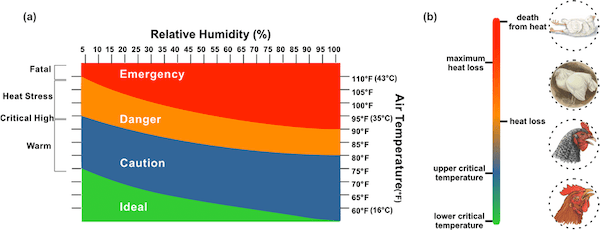Heat stress is weighing heavy on the minds of many producers this year, for themselves as well as their animals. For poultry producers, it’s also an unfortunate fact that the most productive breeds tend to be more prone to heat stress. Karthik Nayani, an assistant professor in the Ralph E. Martin Department of Chemical Engineering at the University of Arkansas, is working on an innovative method of detecting heat stress more quickly than current methods.
Heat stress is one of the major environmental stressors in the poultry industry resulting in substantial economic loss. Heat stress occurs if poultry are outside their “thermoneutral zone” and struggle to regulate their body temperature. Unfortunately, it is also a common challenge in the summer.
Nayani’s research looks at red blood cells of healthy and heat-stressed chickens that will be used to build a data set and develop a rapid reporting technique. Information contained within the red blood cells — dispersed in liquid crystals — will be processed using convolutional neural networks. This type of network works like an algorithm that can read an image and assign it a label. In this case, molecular signatures of heat stress are the image that can be read in order to classify whether heat stress is being experienced.
“Imaging liquid crystals with red blood cells within them provides feature-rich images well suited for classification with neural networks to reveal hidden connections,” explains Nayani. “The goal of this work is to determine if certain features in these images can be connected to molecular signatures of heat stress.” Nayani hopes his research will help farmers more quickly determine whether their poultry is affected by heat stress. The U.S. Department of Agriculture’s National Institute of Food and Agriculture has awarded Nayani a research grant nearing $300,000 to help develop the research into a rapid reporting method.
Heat stress is a physiological response to the combined effect of high ambient temperature and the relative humidity of the air. The comfortable temperature range for poultry is 59-68ºF with birds experiencing mild heat stress at 86ºF. At 98ºF and above, chickens experience severe heat stress. However, in areas of high humidity (above 50%), temperatures above just 68ºF will cause some mild heat stress, and at 86ºF the bird is likely to suffer a stroke. In areas where humidity is not an issue, chickens can survive until temperatures reach 104ºF. At that point, problems can become severe and quickly lead to heat stroke. Heat stroke is generally fatal in chickens.
Birds that are too warm will increase their respiratory rate and divert blood away from the gastrointestinal tract towards their skin, comb and wattles in an attempt to cool down. The overall impact can cause birds to reduce their feed intake by as much as 20%, which has a severe impact on growth, reproductive performance, and egg production. For broiler chicken, if heat stress persists for long periods of time (chronic heat stress) it increases fat content and damages the muscle portion of chicken.
Nayani’s research will focus on broiler chickens, but he says the method can also be conveyed to other types of livestock. According to a report, the overall US livestock production industry suffers an average annual loss of $1.69 to $2.36 billion because of high environmental temperature, out of which the poultry industry accounts for $128 to $165 million. (Sources: University of Arkansas, Poultry World, USDA)








